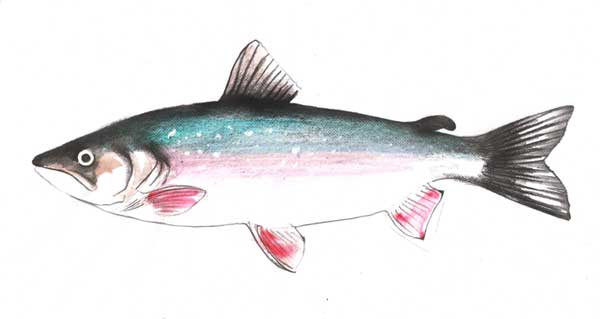
Arctic Char (Salvelinus alpinus)
Current record: 9lb 8oz
Water: Loch Arkaig, Inverness
The charr, also known as char, is a group of freshwater fish species belonging to the Salmonidae family. These cold-water fish are found primarily in the Northern Hemisphere, inhabiting pristine lakes, rivers, and alpine environments. Renowned for their vibrant colors, distinct markings, and high-altitude habitats, charr are valued both ecologically and aesthetically. Among the well-known species are the Arctic charr (Salvelinus alpinus) and the brook charr (Salvelinus fontinalis).
Charr are known for their ability to thrive in cold, oxygen-rich waters, often found in alpine lakes and remote mountain streams. Their adaptability allows them to occupy a variety of habitats, from shallow, rocky shorelines to deep, clear waters. The distinctive coloration of charr varies among species and populations, ranging from silver and olive to deep red and gold. This variability is influenced by factors such as genetics, water temperature, and diet.
Charr exhibit fascinating life histories, with some populations displaying anadromous or landlocked behaviors. Anadromous charr, similar to salmon, migrate between freshwater and saltwater for different stages of their life cycle. Landlocked charr, on the other hand, spend their entire lives in freshwater environments. These diverse life strategies contribute to the ecological richness of the environments they inhabit.
The diet of charr is diverse, encompassing aquatic insects, small fish, and zooplankton. Their feeding behavior often involves hunting near the lake or river bottom. This adaptability in diet, combined with their specific habitat requirements, makes charr excellent indicators of water quality and the overall health of their ecosystems.
Conservation efforts for charr primarily focus on maintaining pristine freshwater habitats, preventing pollution, and managing water quality. Protection of spawning areas, habitat restoration projects, and regulations to control fishing pressures contribute to the sustainable management of charr populations. Due to their sensitivity to environmental changes, the presence of healthy charr populations signifies the well-being of their habitats and underscores the importance of preserving these ecosystems for future generations.
The Arctic char has many traits with lake trout and salmon due to its close kinship with both species. Depending on the season and the environmental factors in the lake where it dwells, the fish's coloration varies greatly. Different populations of Arctic char have different looks. The Arctic char's ventral side ranges from red, yellow, and white, while the dorsal side is dark in colour.
The season and location have an impact on the Arctic char's diet. Arctic chars typically seize opportunities. In the stomachs of Arctic chars, more than 30 different species have been discovered. Arctic char feeds on insects found on the surface of the water, salmon eggs, snails and other small crustaceans found on the lake bottom, and smaller fish up to one-third its size in the late spring and summer. It consumes suspended zooplankton and freshwater prawns in the lake during the autumn and winter, as well as smaller fish on occasion.